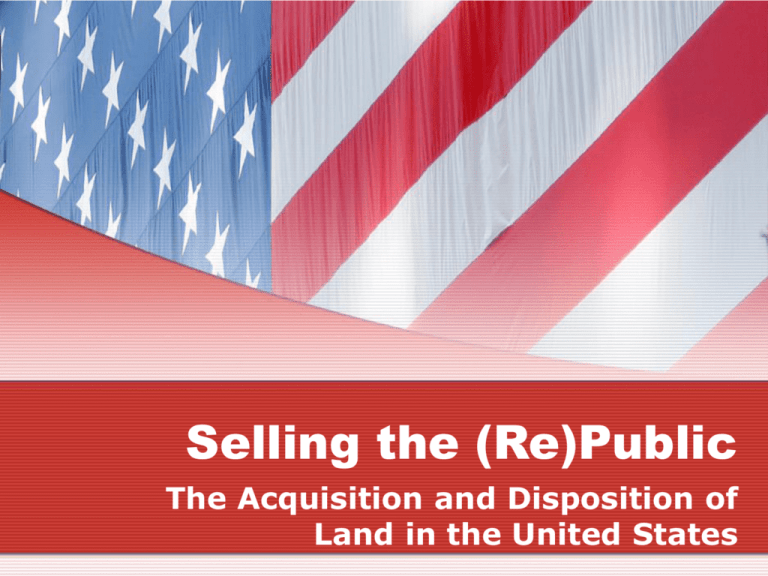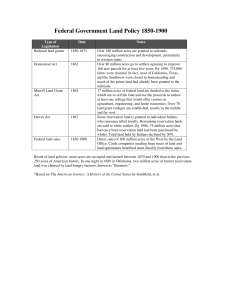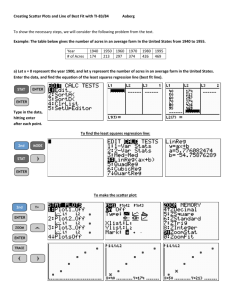Law of Land - College of Business
advertisement

Selling the (Re)Public The Acquisition and Disposition of Land in the United States Acquisition of Territory English Common Law “fee simple” title William the Conqueror Absolute land title limited by 4 government powers Taxation, eminent domain, police power, escheat Can borrow money, sell, and direct it to heirs Allodial title: without government limits Rare, usually owned by the “Crown” Early Land Law Crown Colonies Unappropriated property owned by the Crown Commonwealths Unappropriated property owned by the colony Virginia, Pennsylvania, Massachusetts, Kentucky Government should not own any more land than it needs for specific tasks Liberty and Property John Locke, 1690 “…life, liberty, and estate” Declaration of Independence, 1776 “…life, liberty, and the pursuit of happiness” Virginia Bill of Rights, June 12, 1776 “That all men are by nature equally free and independent, and have certain inherent rights, of which, when they enter into a state of society, they cannot, by any compact, deprive or divest their posterity; namely, the enjoyment of life and liberty, with the means of acquiring and possessing property, and pursuing and obtaining happiness and safety.” Post Revolution Land Claims Several states had claims to land between the Appalachian Mts. and the Mississippi Claiming states could sell land to pay war debts Non-claiming states wanted land claims renounced Claims were renounced for federal assumption of debts Revolutionary War soldiers promised land by the Continental Congress which had none to give State cessions allowed sale and grants of lands, but the Federal Government didn’t get it Northwest Ordinance, 1787 Freedom of Religion, Judicial guarantees, Encouragement of schools, No slavery “whenever any of the said States shall have sixty thousand free inhabitants therein, such State shall be admitted, by its delegates, into the Congress of the United States, on an equal footing with the original States in all respects…” Unappropriated future land remained with US for benefit of federal treasury Pollard v. Hagan, 1845 “Equal Footing” Land previously covered by high tide US Government granted the land Held by previous Spanish Grant Claimant The Constitution did not give maritime land to the US Government; belonged to the states New states have same rights as original states Connecticut Western Reserve Remnant of Connecticut claim maintained after cession of land to Pennsylvania Sold the land to investors, 1796, and reserved 500,000 acres for residents of several New England towns destroyed by the British in the War Louisiana Purchase, 1803 Florida Indian Raids into US Runaway Slaves Pirates Andrew Jackson The Adams-Onís Treaty, 1819 Relinquished claims to East and West Florida and Oregon Missouri Compromise, 1820-21 Land Acts Preemption Act, 1841-1891 160 acres to individual settlers Homestead Act, 1862-1976 160 acres, 5 year residency, house 12 x 14 ft. “Public Land State” grants, 1841-1889 Land given to support transportation, education Morrill Act, 1862 Land to support an agricultural and mechanical college 30,000 acres per senator and representative Railroad Grants Texas American Settlers Slavery & Catholicism Texas Independence, 1835-36 Delayed admission due to slavery issue Texas annexation, admission 1844-45 Texas sold 79 million acres to US Government Parts of NM, OK, WY, CO, KS 1846 Mexican Annexation Mexican-American War Treaty of Guadalupe Hidalgo, 1848 $15 million Gadsden Purchase, 1853 $10 million Rights from the Ranchos Cumbersome process to get patent for own land Many never did Public Lands Nevada Admission in 1864 Enabling Act retained Federal control of unappropriated land 25,000 acre grant for public buildings and a jail Alaska Seward’s Folly, 1867 $7.2 million 365 million acres to public land






